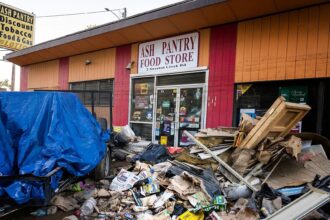In the sweltering heat of summer 2023, global food systems faced unprecedented challenges as climate chaos intensified. From Canadian wheat fields scorched by wildfire smoke to Mediterranean olive groves withering under record temperatures, our dinner plates are increasingly vulnerable to climate disruption. What we’re witnessing isn’t merely an inconvenience—it’s a profound warning about the fragility of global food security in a warming world.
Climate change has transformed from a distant threat to an immediate reality affecting breakfast tables worldwide. Recent data from the UN Food and Agriculture Organization reveals that extreme weather events have damaged crops across six continents simultaneously for the first time in recorded history. The consequences extend beyond availability to affordability, with global food prices increasing by nearly 14% in the past year alone.
“We’re witnessing a perfect storm of climate impacts converging on our food systems,” explains Dr. Margaret Chen, climate resilience expert at the University of Toronto. “The question isn’t whether climate change will affect food production, but rather how quickly we can adapt our agricultural practices and dietary choices to minimize disruption.”
The solutions, while complex, begin with reimagining our plates. Research published in the journal Nature Climate Change demonstrates that dietary shifts could reduce agricultural emissions by up to 70% while improving land use efficiency. Plant-forward diets featuring legumes, grains, and seasonal vegetables require significantly less water, generate fewer emissions, and demonstrate greater resilience to climate shocks than conventional Western diets centered on resource-intensive animal products.
Several Canadian cities have initiated community-based climate-resilient food programs. Toronto’s Urban Agriculture Strategy has converted over 200 acres of urban land to food production since 2020, while Vancouver’s Climate Food Action Plan has reduced the city’s food-related carbon footprint by 18% through local sourcing initiatives and reduced food waste.
The financial implications of our food choices extend beyond personal budgets to national economies. The Bank of Canada’s 2023 economic outlook cites food system vulnerability as a significant inflation risk factor, estimating that climate-related food disruptions could add between 1.2-2.8% to food inflation annually by 2030 if current consumption patterns continue.
“Economic stability and food security are inextricably linked,” notes financial analyst Robert Morrison in a recent CO24 Business interview. “We’re seeing investment capital increasingly flow toward climate-adaptive food technologies and regenerative agriculture as the market recognizes both the risks and opportunities in this space.”
On the global stage, climate-resilient food systems have become a cornerstone of international diplomacy. The recent G20 summit established the Climate-Resilient Food Security Fund with initial commitments of $14 billion to support agricultural adaptation in vulnerable regions. These initiatives acknowledge that food security represents not merely an environmental concern but a fundamental component of geopolitical stability.
Canadian political leaders have proposed legislative frameworks to encourage climate-friendly diets, including tax incentives for sustainable food production and carbon footprint labeling on food products. These policies aim to align market forces with environmental necessities, making climate-conscious food choices more accessible across socioeconomic boundaries.
As we confront these challenges, the path forward requires both individual and collective action. By shifting our diets toward more climate-resilient foods, supporting local production systems, and advocating for policies that prioritize sustainable agriculture, we can build food systems capable of withstanding climate disruptions while nourishing growing populations.
The most compelling question facing us isn’t whether we can produce enough food in a changing climate, but rather: Can we transform our relationship with food quickly enough to prevent cascading crises that threaten both natural systems and human well-being? The answer may well determine whether future generations will enjoy food security or face unprecedented scarcity in the decades ahead.


















